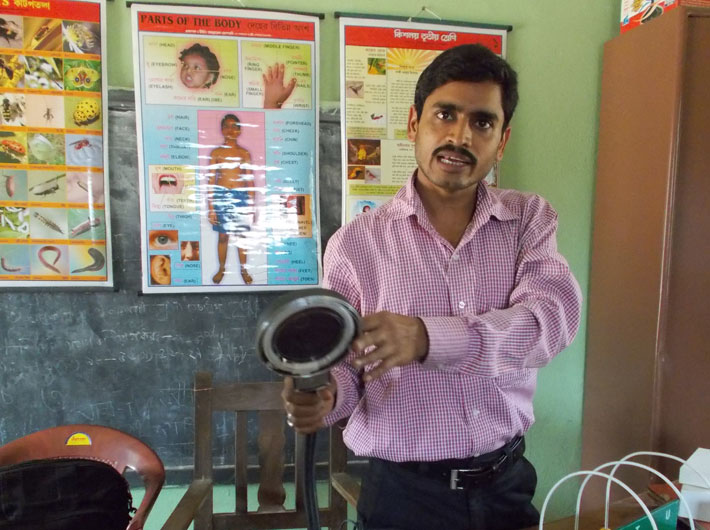With over 700 children with special needs, Salboni is adequately short of expert educators and infrastructure to give the lessons due to them. It’s more an issue of implementation than a systemic snag, say experts
Amrit Das stood on the porch of the headmaster’s office in Salboni high school as his father spoke to one of his teachers, staring straight ahead, oblivious to the general air of chaos and cacophony around him. The conversation over, the boy’s father came up to him and tapped him on the shoulder, gesticulating that they could leave.
Suffering from hearing impairment since birth, Amrit is in class VI now.
Education, though, does not come easy for children like him in such rural settings like Salboni block, in West Medinipur district of West Bengal: having completed primary schooling in Amchura, the boy had to wait two years before he could be admitted to Salboni high school.
But it’s not the school’s fault either, you discover soon.
“We were directed by the sub-inspector of school’s office to admit him (Amrit). But we are not equipped to teach hearing impaired children,” Prakash Mahato, headmaster of Salboni high school, said.
His maths teacher, Satyasadhan Mondal, said: “I have to pay special attention to Amrit to make sure he understands what is being taught. But even then, there is no way of knowing whether he comprehends the lessons.”
While Amrit’s teacher agreed that he is lagging behind his peers — there are 60 students in his class — they do their best to ensure he does not lag too far behind. “Teachers’ learning materials are used to instruct him, besides sign language,” Mondal said. Amrit, he added, can communicate through written words.
Soumen Pan, who taught the boy at the primary school in Amchura, said Amrit needed some special attention. “After primary school we tried getting him admitted in a school of children with special needs. But there was no vacancy. That is when the special needs educator intervened and secured him an admission in Salboni high,” Pan said.
Treating them right
At the office of sub-inspector of schools, special educator Rajkumar Bhuniya said that since the beginning of inclusive education, children with special needs (CWSN) attend classes with general students. “Children with severe levels of impairment can be admitted to special schools, while those with mild (or) moderate category attend school with regular students,” he said.
Admitting that the needs of these children cannot be fulfilled in classrooms, Bhuniya said, “That is why we have a resource room that can be accessed by children with special needs twice a week. A special educator sits with the child and helps him/her clear the backlog.”
In the resource room, Amrit is taught to communicate through sign language and helped with his studies. Children are also given therapies. Visually impaired children are taught Braille, children with locomotor disability are given locomotor therapies, while the motor skills of mentally retarded children are refined.
“Through the resource room we give these children a support service to address their special needs,” special educator Uma Chakrabarty Das said. Bhuniya, on his part, said it is “completely up to the parents” to decide whether they want to avail of the resource room facilities.
An official said special schools are the best option for children with special needs but parents are often unwilling to send their children away. “These special children are given Rs 3,000 per year to meet the cost of commuting. But this allowance is stopped if they attend special school, which is a reason why most families are not willing to admit their children in special schools,” the official reasoned.
Infrastructure issues
There are only two resource rooms in Salboni: at Mandalkupi primary school in Sadar north circle and at Pirakata primary school in Sadar south.
And the problem begins right there: the whole block has only three special needs educators, and two of them cater to Sadar north, which has 380 children with special needs, most of them being mentally disabled.
Sadar south circle, with 357 children with special need, has only one special educator.
“Under the circumstances, it is tough for us to address the needs of these special children, especially the mentally challenged,” Bhuniya said.
Location of the two resource rooms — at two ends of Salboni — also makes it difficult for people to access them. “There is only one resource room at the circle level and many children with special needs cannot access it due to problems of commuting. Ideally, every gram panchayat should have one resource room,” special educator Uma Chakrabarty Das said.
The resource room at Mandalkupi does not have electricity, rendering the reading lamps for those with low vision useless. Bhuniya said such reading lamps have been given to many children with low vision through camps.
The resource centre at Pirakata, meanwhile, has no therapy equipment, Das said. “I give speech therapy and look after the remedial teaching for mentally disabled and visually impaired children,” Das added.
What needs to be done
“Learning disability is not recognised under persons with disability Act,” Bhuniya said, “but children with learning disability can access facilities at the resource room as well.”
The problem, officials said, is though the system is in place, its implementation is bad.
For starters, Bhuniya said, people do not bring their children to the resource room regularly, which delays their learning. At the resource room, while Bhuniya said most equipment needed for therapy and teaching are available the equipment need to be upgraded.
While the aim of Sarva Shiksha Abhiyan is education for all, it becomes a tad difficult in unfavourable circumstances. In 2012-13, sarva shiksha mission had allotted Rs 32,000 to upgrade the resource room. “We provide children who come to the resource room with food and travel allowance,” Bhuniya said.
According to him, funds for four more resource rooms are expected to be sanctioned in the ongoing financial year.
Besides, all higher secondary schools have been given Rs 10,000 to construct ramps so that children with locomotor disability can attend school without any help.
But funds apart, the need for experts is also telling. “We need more special educators,” Das pointed out. “Besides attending to the children with special needs, we have to take care of paperwork and undergo training. I am the only special educator in my circle and it becomes very difficult to manage everything.”
Special educators also need to visit homes of the children and sometimes schools, where they train the teachers, Das added.
Due to shortage of special educators, the special children cannot avail facilities of the resource room regularly, Das said.
Amid all this, children like Amrit Das, have to rely on the system in the absence of options and try to make the best out of it.



